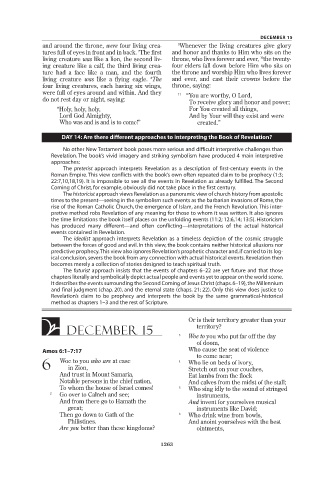Page 1282 - The MacArthur Daily Bible
P. 1282
TN_12_MacArthur_Bible_Dec.qxd 8/8/03 17:33 Page 1263
DECEMBER 15
and around the throne, were four living crea- 9 Whenever the living creatures give glory
7
tures full of eyes in front and in back. The first and honor and thanks to Him who sits on the
living creature was like a lion, the second liv- throne, who lives forever and ever, the twenty-
10
ing creature like a calf, the third living crea- four elders fall down before Him who sits on
ture had a face like a man, and the fourth the throne and worship Him who lives forever
8
living creature was like a flying eagle. The and ever, and cast their crowns before the
four living creatures, each having six wings, throne, saying:
were full of eyes around and within. And they 11 “You are worthy, O Lord,
do not rest day or night, saying:
To receive glory and honor and power;
“Holy, holy, holy, For You created all things,
Lord God Almighty, And by Your will they exist and were
Who was and is and is to come!” created.”
DAY 14: Are there different approaches to interpreting the Book of Revelation?
No other New Testament book poses more serious and difficult interpretive challenges than
Revelation. The book’s vivid imagery and striking symbolism have produced 4 main interpretive
approaches:
The preterist approach interprets Revelation as a description of first-century events in the
Roman Empire. This view conflicts with the book’s own often repeated claim to be prophecy (1:3;
22:7,10,18,19). It is impossible to see all the events in Revelation as already fulfilled. The Second
Coming of Christ, for example, obviously did not take place in the first century.
The historicist approach views Revelation as a panoramic view of church history from apostolic
times to the present—seeing in the symbolism such events as the barbarian invasions of Rome,the
rise of the Roman Catholic Church, the emergence of Islam, and the French Revolution.This inter-
pretive method robs Revelation of any meaning for those to whom it was written. It also ignores
the time limitations the book itself places on the unfolding events (11:2; 12:6,14; 13:5). Historicism
has produced many different—and often conflicting—interpretations of the actual historical
events contained in Revelation.
The idealist approach interprets Revelation as a timeless depiction of the cosmic struggle
between the forces of good and evil. In this view, the book contains neither historical allusions nor
predictive prophecy.This view also ignores Revelation’s prophetic character and,if carried to its log-
ical conclusion, severs the book from any connection with actual historical events. Revelation then
becomes merely a collection of stories designed to teach spiritual truth.
The futurist approach insists that the events of chapters 6–22 are yet future and that those
chapters literally and symbolically depict actual people and events yet to appear on the world scene.
It describes the events surrounding the Second Coming of Jesus Christ (chaps.6–19),the Millennium
and final judgment (chap. 20), and the eternal state (chaps. 21; 22). Only this view does justice to
Revelation’s claim to be prophecy and interprets the book by the same grammatical-historical
method as chapters 1–3 and the rest of Scripture.
Or is their territory greater than your
December 15 territory?
3
Woe to you who put far off the day
of doom,
Amos 6:1–7:17 Who cause the seat of violence
to come near;
6 Woe to you who are at ease 4 Who lie on beds of ivory,
in Zion,
Stretch out on your couches,
And trust in Mount Samaria, Eat lambs from the flock
Notable persons in the chief nation, And calves from the midst of the stall;
To whom the house of Israel comes! 5 Who sing idly to the sound of stringed
2
Go over to Calneh and see; instruments,
And from there go to Hamath the And invent for yourselves musical
great; instruments like David;
Then go down to Gath of the 6 Who drink wine from bowls,
Philistines. And anoint yourselves with the best
Are you better than these kingdoms? ointments,
1263

